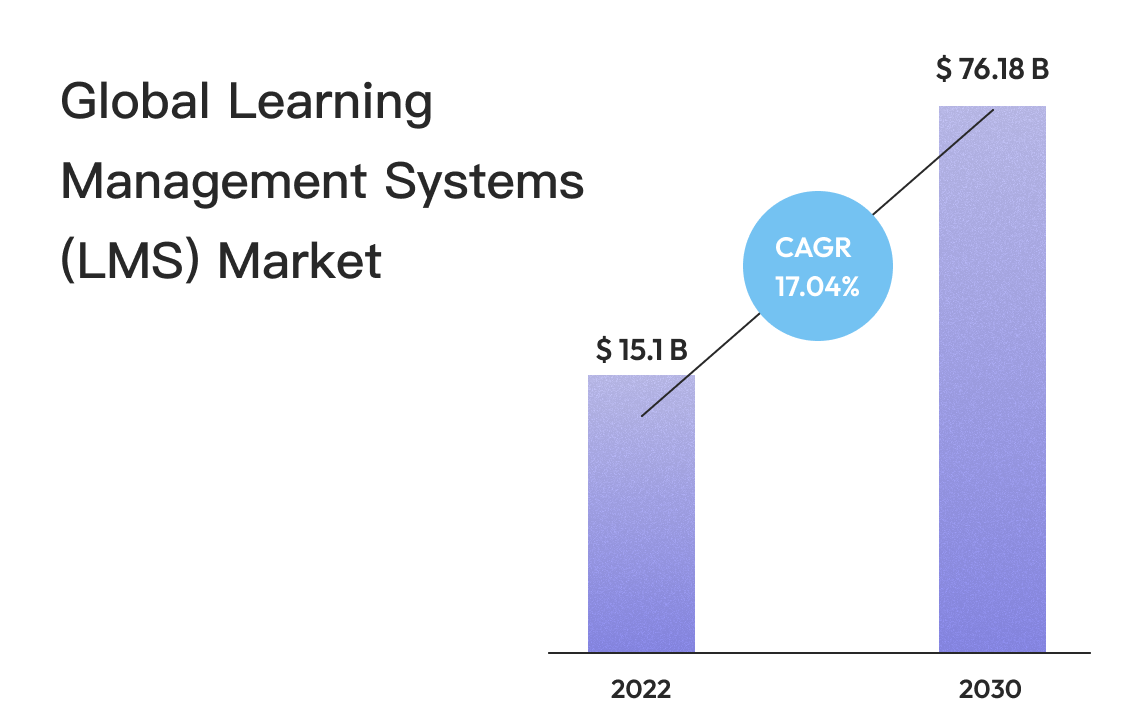How to Develop A Learning Management System (LMS) from Scratch?
- Web
- December 21, 2023
Learning is no longer just about referring to heavy-weighted books and making tedious notes of them, neither is it confined to quantifiable categories; anyone can teach anything.
If the concept of learning itself is boundaryless, then why would the medium of learning have one?
Today, we have come across many robust educational or e-learning portals that are apt platforms for many educators out there. But, how it is created is a different fascination altogether, don’t you think? Well, there is a thing called the learning management system that is the core of e-learning platforms.
Our topic for today is to help you learn how to create a fully-fledged LMS, i.e. learning management system from scratch. Well, this guide is going to help you with every insight that contributes to making your LMS the best of all. Should we begin with it?
Let’s understand the roots first.
What is a Learning Management System?
A learning management system is an online management system that automates the learning processes. Also, a learning management system allows instructors to share and manage their training programs.
In order to help educators enlighten their students, a learning management system (LMS) makes use of various tools that automate and unravel an entire process by simplifying the making of educational content like scripts, audio, video material, presentations, and so on.
LMS not only simplifies the educational content but also establishes a whole learning process through detailed pacing, multiple assessments, a grading system, and a lot more.
There are two main components that essentially make up learning management software:
Admin panel – It provides control over all system interactions, including creating new courses, managing existing ones, communicating with learners, and evaluating progress.
User panel – This interface allows learners to register for the course and access the learning materials.
Types of Learning Management Systems
Let’s learn about different types of learning management systems in this section:
1. Server-based learning management systems
The server LMS is meant to be installed on the owner’s server and it interacts with users via a browser. Universities first utilized this type of LMS and it is still used today. Furthermore, large corporations with a high level of information security and system control prefer it.
The demerits of server-based distance learning systems are the costs of acquiring a server, software, and administration.
2. Cloud-based learning management systems
Cloud solutions are the most commonly used distance learning platform. They are highly chosen by both private online school owners and business leaders in order to enhance their corporate learning due to their seamless and simplistic architecture. You simply pay for the use of the cloud, which means there is no need to purchase or manage a server.
There are ready-made training management systems available on the market as well as systems that can be upgraded with new features based on the objectives and specifics of training. To maximize the benefits of ready-made solutions, you must embrace their capabilities, acknowledge their limitations, and adhere to their standards. The use of open-source solutions is becoming increasingly common among businesses and educational institutions.
Now that we have understood the purpose and types of a learning management system, the next question that possibly arises is what kind of audience exactly needs that. So, time to discuss that next?
How Can an LMS Platform Be Used?
The market of LMS is vast because it has multiple usages. LMS System Market size was valued at USD 15.1 Billion in 2022 and is anticipated to reach USD 76.18 Billion by 2030, growing at a CAGR of 17.04% from 2023 to 2030.

There are a lot of things that you need to know before you actually start working on building an LMS. You need to know which kind of audience will be using it. So, here we are listing down a few most common categories of an LMS platform:
Sales training
A learning management system helps sales guys with the necessary enlightenment that really helps them improve their sales tactics to scale up relatively.
HR solutions
It is a unique ability to automate up to 70% of the routine work of the personnel department by digitizing databases and documents.
The evolution and retention of employees
In a learning management system’s framework, educational programs are assigned to employees in order to help them acquire the required skills with respect to current trends. LMS in terms of employees’ growth and development, is availed to assess the knowledge of every single employee, regulatory documents, tolerances, and certifications.
Customer training
Such kinds of programs are generally for firms who want to adapt their strategies to gain traction and improve their user engagement in products. The Availing of these programs unveils many useful techniques to capture users’ attention.
Remote work
Since remote work is getting promoted on a serious note after digitization has taken a major part of the corporate sector, there are many productive programs available for employees to maintain their efficiency while working remotely on the LMS platform.
Now that we have understood a few of the most common usages of a learning management system, let’s help you delve a little deeper into this. What should be your thought process before working on an LMS? Let’s learn about that.
How to Develop the Ideation of Creating a Learning Management System?
Working on a learning management system calls for a robust plan behind creating that; the purpose of creating an LMS should be clear to the entire team. Here are a few points for you to sleep on your purpose:
What makes you different from the others? Is your change desirable in the market?
First things first, your train of thought should keep your target audience and market forces at its core; does your idea offer value? You need to conduct solid market research about current trends with respect to your idea of launching an LMS. Not just that, absorb the scenario of the market and reiterate your current plan if required.
This is the base of your plan, conduct an in-depth analysis of your idea and launch your plan only after you have an absolute surety:
- You need to know the level of demand for your product in order to plan accordingly.
- To reduce marketing costs, save time, and improve conversions through targeted advertising.
- Communicate effectively with your audience by selecting the best communication methods.
- A sales channel and tool selection analysis will be conducted to determine which is most effective.
- Developing a business model for your LMS is another important step.
Now that you have understood the importance of clarity you should have it before you are about to work on a process of creating a learning management system. It’s finally time to reach the most important segment of this blog: a guide to create an effective learning management system.
How to Create a Learning Management System?
Time to learn about how to create a learning management system with this all-inclusive guide. Let’s get started:
1. Research and mindfully conceptualize your strategy
In this whole article, we have emphasized research and mindfully planning out your strategy to launch your product, it is because the more you research the better you plan out your tactic.
An unplanned LMS launch carries a high chance of failure, many organizations fail to significantly consider doing research and development before launching a learning management system and then they get to face the repercussions.
Whereas a well-planned LMS launch helps you gain insights about consumer behavior, consumer expectations, prevailing market trends, and a lot more rational information that helps you improve your LMS launch strategy.
Ask yourself these following questions to validate your idea about a learning management system:
- What is the purpose of an LMS?
- Is my LMS going to address any user issues?
- LMS development will be handled by whom?
- In what amount does the LMS team plan to develop the system?
- Who are my competitors, and how do they help users with efficient UX?
2. Opt for an apt technology stack
Opting for an apt web development stack is something that decides how your learning management system will perform in the future in terms of technicalities. So, while choosing a technology stack, consider the type and functionality of your custom LMS solution, robust frontend, and backend, and hosting technologies that play their part while creating an efficient learning management system.
So, these are the top frontend and backend frameworks that are highly used in the year 2023 already. For databases, you can go for MySQL, MongoDB, or PostgreSQL for speed, reliability, and compliance.
When it comes to Databases, a learning management system is connected to relational databases like MySQL and PostgreSQL, these two databases are super compliant, robust, reliable, and rapid.
If we talk about cloud-based learning management system development then AWS (amazon web services) is the top choice as it’s known for its robust security, budget-friendly price, and productivity.
3. Create a learning management system specification and UI/UX design
Now that you have meticulously decided on the web development stack and have balanced out the list of all features, it is time to move towards a learning management system’s specification.
Deciding on a learning management system’s specification calls for a discovery phase with a robust team that possesses strong technical and communicational skills as well as holds the expertise to formulate logical questions and help you derive all the required information to make your learning management system next to what you expected.
At this stage, you are also required to form a schematic representation of the final LMS and budget estimation for the same.
After deciding on the specifications of a learning management system, designers conceptualize the UI/UX of the LMS in that accordance. Then they will begin with creating LMS mockups and wireframes for complex architectures, if everything is finalized in terms of design then the designs will be passed to developers for turning into a functional product.
4. Begin with the MVP launch of the learning management system
It is advisable to launch a minimal viable product at first so that you do not really have to rework the product based on the reviews you will receive from users.
Minimal viable product contains only core features of the learning management system so that when people start interacting with the product while BETA testing, they get a thorough understanding of an LMS and based on their reviews you can work on the rest of the features.
That way you will end up offering a favorable user experience since you have thoroughly studied and addressed users’ feedback and worked accordingly on further product development.
Once you have launched the final product, you are aware that users are going to appreciate it as the final product is certainly as per their preferences.
5. Release the final learning management system
Since you have gathered all the necessary information and metrics related to the MVP of your learning management system, all you need to do is to implement all the rational feedback that you received which will ultimately help you improve the user experience of the product.
The process of release management cycle:
- Request for changes of new features
- Release planning and design
- Software Build
- Review
- Test
- Deployment
- Support
- Issue Reporting and Collection
6. Launch and maintenance of a learning management system
We deploy the code as soon as testing shows that each feature works as expected by our client. To keep everything in order and avoid delays, our team employs the best software development life cycle methodology. Before the launch day, we also create a comprehensive guide on how to use the LMS features.
Apart from that, we provide end-to-end support and maintenance services after personalized LMS development is completed, and the system is fully operational. As you track the software’s functionality and gather user feedback, you can request modifications and/or changes.
Alright, here you achieved the biggest milestone. Now let’s pay attention to these surprising points that will differentiate your LMS from the existing ones in the market. Time to check it out?
4 Things That Can Help You Create The Best Learning Management System
Considering these 4 points while working on an LMS can help you generate the best learning management system, let’s check it out:
1. In-depth third-party integration
A learning management system is a multifunctional forum that offers instructors a platform to execute their knowledge skillfully to educate their target audience. So creating a 3rd party integration in an LMS requires a good understanding of both the LMS and the third-party application, as well as strong development skills and attention to detail.
Right from defining the integration requirements, and choosing the integration method to deploying the same. It all has to be carried out mindfully.
2. Support the most famous multimedia formats
The characteristics of a favorable learning management system should be ideally revolving around its multifunctional element. This is for allowing the educational process to be quite engaging and divergent.
Thus, both the learners and the staff should adopt the ability to communicate with multiple multimedia formats, such as text, audio, video, and photos.
3. Single login-all the functionality
Creating a different portal for students, teachers, and parents is something that will consume your unnecessary bandwidth. Splitting up an LMS is not a good idea. Instead, you can create a single learning management system for all to provide all the required insights through a single software.
4. Customize where it is actually required
Apply your process of customization where it is actually required. You can provide a separate toolkit for the educators for the betterment of their way of instructing their students. That way you are setting a beneficial and customized learning environment for students and adaptive options for teachers.
5 Key Features of Learning Management System
Including these 5 features will allow your learning management system to stand out in the eyes of users and will become a prime choice for them when it comes to choosing an LMS. Let’s check it out:
1. Content Management
The core objective of any learning management software is to train and teach students and employees. This is a vital LMS feature because it enables instructors to develop content and courses for learners and staff. You can use this tool to build anything, including a course, assignment, test, or project.
2. Skills Assessment
Skill assessment is one of the most crucial features of learning management systems for determining whether the training you offer is working well for your users or not. Such systems should contain a tool for tracking and analyzing user skills to make sure they are on the perfect track. Common methods of skill evaluation include tests, quizzes, and assignments.
3. Advanced Reporting
LMS reporting and analytics are two of the most critical features. Create a learning management app that generates reports on training history, course activity, test results, and so on using descriptive data. The system should also allow you to export and send the report to learners so that they can track their educational progress.
4. In-App Collaboration
In-app collaboration emphasizes group learning and offers real-time communication, a virtual community, along with problem-solving capabilities. It might be user-generated materials, a forum, team-based games for learning, and a lot more. Making learning a shared activity is what it mainly focuses on.
5. Gamification
Gamification is a technique that incorporates elements of game design and mechanics into a learning environment to increase engagement, motivation, and participation among learners.
It involves various game-like features, such as badges, points, levels, leaderboards, challenges, and rewards to motivate and engage learners. These game elements are designed to make the learning experience more fun, interactive, and engaging for learners, making it easier for them to absorb and retain information.
So, this is where we sign off with the insightful session. We would like you to read how we can be a source of assistance when it comes to creating a learning management system.
Summing It Up – How MindInventory Can Be a Source of Help?
Putting an end to this discussion, we hope that you now have gathered a bunch of fruitful insights that will surely help you create an effective learning management system for your business. An LMS that helps educators and learners connect on the basis of its medium and helps businesses generate ROI.
As a leading software development company with many years of experience in the education industry, our team of expert developers does follow the work patterns that are suitable for our client’s requirements and help them achieve their objectives rapidly. Our sole objective is to be a part of your success with our technical contributions. So, are you ready to associate with us?

FAQs on Learning Management System (LMS)
An LMS is a piece of software that allows users to create, design, and deliver their own course content via a website or a mobile app. eLearning platforms, on the other hand, are web-based applications that allow users to create and deliver online courses to learners.
Moodle, Blackboard, Schoology, Google Classroom, Canvas by Instructure, D2L Brightspace, Absorb LMS, LearnDash, and many others are popular examples of learning management systems.
Generally, the cost of developing a learning management system depends on many factors, like the complexity of the LMS platform, the number of features, the design complexity, the team’s expertise, the selected technology stack, etc. Contact us with your project concept to know the exact cost and time estimation.













